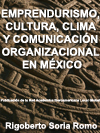
EMPRENDURISMO, CULTURA, CLIMA Y COMUNICACI?N ORGANIZACIONAL Y SU APLICACI?N A LA PEQUE?A Y MEDIANA EMPRESA EN LA ZONA METROPOLITANA DE GUADALAJARA, M?XICO
Coordinador: Rigoberto Soria Romo
Bibliografía
Abello Gual Jorge. (2005) Cooperativismo como Alternativa Empresarial al Problema Laboral, Revista de Derecho. Universidad del Norte, Colombia, 23: 322-340.
Ajiferuke, M. y Boddewyn, J. (1970). "Culture and Other Explanatory Variables in Comparative Management Studies, The Academy of Management Journal, 13 (2) 153-163.
Allaire, Y. and M. E. Firsirotu (1984). Theories of Organization Culture, Organizacional Studies, 6: 117-138.
Andrade Romo, Salvador y Martha Fernández Rubalcaba. (1999) De la Capacidad para Emprender Pequeños negocios a la Capacidad Emprendedora en Organizaciones ya Consolidadas, Administración y Organizaciones: 81-108, Universidad de Chihuahua, México.
Apelqvist, Katarina. (1996) Estrategias para una Autoridad Compartida entre Hombres y Mujeres en las Cooperativas. Revista de Cooperación Internacional, 1: 35-47.
Baligh Helmy H. (1994), Components of Culture: Nature, Interconnections, and Relevance to the Decisions on the Organization Structure, Management Science, 40 (1) 14-27.
Barney Jay B. (1986), Organizational Culture: Can It Be a Source of Sustained Competitive Advantage?. The Academy of Management Review, 11 (3) 656-665
Brouwer, Maria T. (2002) Weber, Schumpeter and Knight on Entrepreneurship and Economic Development. Journal of Evolutionary Economics, 12: 83-105.
Busenitz Lowell W., G. Page West III, Dean Shepherd, Teresa Nelson, Gaylen N. Chandler y Andrew Zacharakis. (2003). Entrepreneurship Research in Emergence: Past Trends and Future Directions. Journal of Management. 29: 285-308.
Daeren, L. (2000), Mujeres Empresarias en América Latina: El Difícil Equilibrio entre dos Mundos de Trabajo. Desafíos para el Futuro, CEPAL, Chile.
Dávila A., y Martínez, N. (1997), Debates en la Teoría de la Cultura de las Organizaciones: Una propuesta de integración. ITESM, Campus Monterrey.
Dávila A., y Martínez, N.(1999), Cultura en Organizaciones Latinas, Siglo XXI editores, ITESM, Campus Monterrey, México.
Deal, T. y Kennedy, A. (1982), Corporate Cultures, Reading, MA: Addison-Wesley
Denison Daniel R. , Mishra Aneil K. (1995), Toward a Theory of organizational Culture and Effectiveness. Organization Science, 6 (2) 204-223.
Díaz Bretones, Francisco. (2000) Desempleo y Cooperativismo, Revista de Economía Pública, Social y Cooperativa. CIRIEC-España. 35: 161-176.
Eguía Villaseñor, Florencio. (1994) ABC de la Cooperación, Grupo Parlamentario LV Legislatura, México.
Harrison M. Trice; Janice M. Beyer (1984), Studying Organizational Cultures through Rites and Ceremonial. The Academy of Management Review 9 (4) 653-669.
Hatch, Mary Jo (1993), The Dynamics of Organizational Culture. The Academy of Management Review, 18 (4) 657-693.
Hisrich, Robert; Peters Michael y Dean Shepherd. (1989). Entrepreneurship. New York: McGraw Hill.
Howard, Ecklund, E. (2003), Catholic Women Negotiate Feminism: A Research Note, Sociology of Religion, 64 (4) 515-524.
Iannaccome, Laurence R. (1998), Introduction to the Economics of Religion. Journal of Economic Literatura, 36 (3) 1465-1495.
Ibargüen Tinley, L. (2006), Comercialización de Productos Herbolarios como Alternativa Productiva en Comunidades Rurales: Reflexiones Preliminares en Torno a una Microempresa en Veracruz, Asociación Mexicana de Ciencias para el Desarrollo Regional, A.C., México.
Jelinek Mariann; Smircich Linda; Hirsch Paul (1983), Introduction: A Code of Many Colors, Administrative Science Quarterly, 28 (3) 331-338.
Kantis, M. et al. (2002), Empresarialidad en Economías Emergentes: Creación y Desarrollo de Nuevas Empresas en América Latina y el Este de Asia, BID.
López Espinoza, M. (2002), Estudio sobre Migraciones Internacionales, Oficina Internacional de Trabajo, Suiza.
Nieto Figueras, Cristina. (2006) Las Mujeres y el Cooperativismo en los Procesos de Desarrollo local, Doc. Anales de Geografía, Universidad de Málaga, España, 47: 31-52.
Martinson Oscar B.; Wilkening Eugene A. (1983), Religion, Work Specialization, and Job Satisfaction: Interactive Effects. Review of Religious Research, 24 (4) 347-356.
OIT (2002), ILO General Survey 2001 on Employment Related Conventions and Recommendations: Analysis of Member States Responses to Recommendation 189 (Job Creation in Small and Medium-Sized Enterprises)
Organization for Economic Co-operation and Development (2001), Women in Entrepreneurs in SMEs, France.
Reynolds, P. et al. (2000). Global Entrepreneurship Monitor, 2000 Executive Report. Kansas City: Kauffmann Center for Entrepreneurial Leadership.
Ribas Bonet, Ma. Antonia y Antonia Sajardo Moreno. (2005) La Diferente Participación Laboral de las Mujeres entre las Cooperativas y las Sociedades Laborales, Revista de Economía Pública, Social y Cooperativa. CIRIEC-España, 52: 267-258.
Rossi, Ino y Edwin O´Higgins (1980). The development of theories of culture. People in Culture. In Ino Rossi (ed.), pp. 31-78. New York: Praeger.
Saffold, Guy S. (1998), Culture Traits, Strength and Organizational Performance: Moving Beyond Strong Culture, The Academy of Management Review, 13 (4) 546-558.
Schein Edgar (1992), Organizational Culture and Leadership, San Francisco: Jossey-Bass
Schein Edgar (1996), Culture: The Missing Concepts in Organization Studies , Administrative Science Quarterly, 41 (2) 229-240, Anniversary Issue.
Senger John, (1970), The Religious Manager, The Academy of Management Journal, 13 (2) 179-186.
Seul, Jeffrey R. (1999). Our is the Way of God: Religion, Identity, and Intergroup Conflict, Journal of Peace Research, 36 (5) 553-569.
Smircich Linda (1983), Concepts of Culture and Organizational Analysis, Administrative Science Quarterly, 28 (3) 339-358.
Smircich Linda, Jelinek Mariann, Hirsch Paul, (1983), Introduction: A Code of Many Colors, Organizational Culture, 28 (3) 331-338.
Smircich Linda (1995), Writing Organizational Tales: Reflections on Three Books on Organizational Culture, Organization Science, 6 (2) 232-237.
Thompson, Arthur A. Jr. y A. J. Strickland III (2003). Administración Estratégica, textos y casos. México: Mc Graw Hill, decimotercera edición.
Trice, H. y Beyer, J. (1992). The cultures of work organizations. Englewood Cliffs, NJ: Simon & Schuster.
Vitols, Sigurt. (1995) German Banks and the Modernization of the Small Firm Sector: Long-Term Finance in Comparative Perspective, Discussion Paper FS I 95-309. [En línea]: http://bibliothek.wz-berlin.de/pdf/1995/i95-309.pdf.
Wilkins Alan L. y Ouchi William G. (1983). Efficient Cultures: Exploring the Relationship between Culture and Organizational Performance, Administrative Science Quarterly, 28 (3) 468-481.
Wilkins, Alan L.; Dyer W. Gibb (1988), Toward Culturally Sensitive Theories of Culture Change, The Academy of Management Review, 13 (4) 522-533.
Worthy, James C. (1958), Religion and its Role in the World of Business, The Journal of Business, 31 (4) 293-303.
